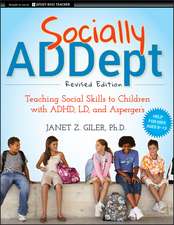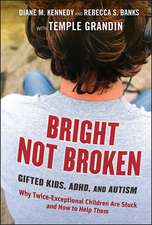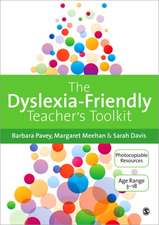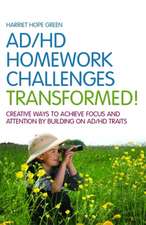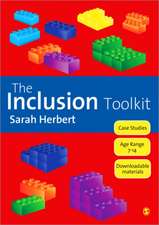The Special Educator's Guide to Collaboration: Improving Relationships With Co-Teachers, Teams, and Families
Autor Sharon F. Crameren Limba Engleză Paperback – 22 mai 2006
General and special education teachers working side by side on a daily basis must move beyond basic communication to improve collaborative relationships in and outside the classroom. Author Sharon F. Cramer delves into the art of the collaborative process through a series of practical exercises coupled with relevant research, and outlines a plan to make collaboration a life-long part of teaching. Pre-service teachers, in-service teachers, and staff developers alike can use the activities in the book as is or adapt them to fit their own unique circumstances.
Whether used for personal improvement or by a group for professional development purposes, these invaluable set of relationship-building tools will empower teachers and give them the motivation, understanding, and skills to transform unsatisfactory co-teaching relationships into productive, truly collaborative relationships. Special features include:
o Case stories and data from among 1,000 collaboration projects supervised by the author
o Up-to-date research, including an overview of current literature on collaboration
o "Idea try-outs"-step-by-step reflection activities for promoting independent, innovative thinking
o "Project try-outs"-structured research and interview activities that provide readers with focused ways to test their collaboration skills
When teachers become curious, motivated learners, not only will they discover the many benefits of collaborative relationships with their peers, but they will also enrich the learning environment for their students.
Preț: 277.86 lei
Nou
Puncte Express: 417
Preț estimativ în valută:
53.17€ • 55.66$ • 43.99£
53.17€ • 55.66$ • 43.99£
Carte tipărită la comandă
Livrare economică 07-21 aprilie
Preluare comenzi: 021 569.72.76
Specificații
ISBN-13: 9781412914918
ISBN-10: 1412914914
Pagini: 360
Dimensiuni: 216 x 279 x 19 mm
Greutate: 0.84 kg
Ediția:Second Edition
Editura: SAGE Publications
Colecția Corwin
Locul publicării:Thousand Oaks, United States
ISBN-10: 1412914914
Pagini: 360
Dimensiuni: 216 x 279 x 19 mm
Greutate: 0.84 kg
Ediția:Second Edition
Editura: SAGE Publications
Colecția Corwin
Locul publicării:Thousand Oaks, United States
Recenzii
"The
valuable
information
and
numerous
strategies
and
resources
make
this
a
must
have
book
for
all
teachers
striving for
effective
collaborative
relationships
with
others."
Cuprins
Preface
to
the
Second
Edition
Acknowledgments
About the Author
1. Why Can’t We Just Be Friends?
Becoming Proactive: Improving the School Climate Through Collaboration
Overview of the Collaboration Project
Principals of Collaboration
Distinguishing Between Collaboration, Consultation, and Teaming
Conclusion
2. Background: Making the Case for Collaboration
Legislative Mileposts
Collaboration: Relevant Trends and Events
Conclusion
3. Ingredients for Successful Collaboration: Intrapersonal and Interpersonal Characteristics
Intrapersonal Foundation for Collaboration
Interpersonal Foundation for Collaboration
Problem Solving: Intrapersonal and Interpersonal Skills
Bringing It All Together
4. Evaluating Your Situation Honestly: Appraising Your School as a Context for Collaboration
Assessing Resources Available to Collaborators
Factors Promoting Collaboration
Applications to Use in Your School Setting
Communitywide Collaboration Experiments
5. Developing an Effective Collaboration Strategy: Half Empty or Half Full?
Collaboration Component Checklists
Compatibility Checklist
Success Checklist
Conclusion
6. Designing a Plan for Change Starting With You
Guidelines for the Collaboration Project
Designing a Self-Referential Plan for Collaboration
Overview of Pragmatic Goals
Development of Pragmatic Goals and Objectives
Incorporating Expertise: Marshaling Resources
7. What Now? What Works and What Doesn’t When Collaborating
Effective Communication Strategies: Something for Everyone
Accomplishing Pragmatic Goals and Associated Evaluation Methods
Making Use of Your Collaboration Resource Network
Conclusion
8. Evaluating the Success of Your Plan: How Can You Tell?
Objective Measures of Change
Subjective Measures of Change
Conclusion
9. Self-Encouragement: Keeping Yourself Going
Self-Talk: The Cornerstone for Self-Encouragement or Self-Discouragement
Looking for the Positives: Positive Reinforcement for Yourself
Sample Projects Incorporating Reinforcement
Teaching Yourself to Look: Observing Yourself
Conclusion
10. Summing Up the Outcomes: What Have You Accomplished?
Assessing Success: How Did Your Plan Work Out?
Communication Habits
Problem-Solving Habits
Cooperative Work Efforts
Conclusion
11. Generalizing Your Plan to Others: Improved Collaboration With Parents and Family Members of Your Students
Key 1: Understanding Family Diversity
Key 2: Developing Practical Communication Habits
Key 3: Build on What You’ve Already Learned
Conclusion
12. Generalizing Your Plan to Others: Improved Collaboration With Members of Your Interdisciplinary Team
The Life Cycle of Your Interdisciplinary Team
Additional Use of Teams
Conclusion
References
Index
Acknowledgments
About the Author
1. Why Can’t We Just Be Friends?
Becoming Proactive: Improving the School Climate Through Collaboration
Overview of the Collaboration Project
Principals of Collaboration
Distinguishing Between Collaboration, Consultation, and Teaming
Conclusion
2. Background: Making the Case for Collaboration
Legislative Mileposts
Collaboration: Relevant Trends and Events
Conclusion
3. Ingredients for Successful Collaboration: Intrapersonal and Interpersonal Characteristics
Intrapersonal Foundation for Collaboration
Interpersonal Foundation for Collaboration
Problem Solving: Intrapersonal and Interpersonal Skills
Bringing It All Together
4. Evaluating Your Situation Honestly: Appraising Your School as a Context for Collaboration
Assessing Resources Available to Collaborators
Factors Promoting Collaboration
Applications to Use in Your School Setting
Communitywide Collaboration Experiments
5. Developing an Effective Collaboration Strategy: Half Empty or Half Full?
Collaboration Component Checklists
Compatibility Checklist
Success Checklist
Conclusion
6. Designing a Plan for Change Starting With You
Guidelines for the Collaboration Project
Designing a Self-Referential Plan for Collaboration
Overview of Pragmatic Goals
Development of Pragmatic Goals and Objectives
Incorporating Expertise: Marshaling Resources
7. What Now? What Works and What Doesn’t When Collaborating
Effective Communication Strategies: Something for Everyone
Accomplishing Pragmatic Goals and Associated Evaluation Methods
Making Use of Your Collaboration Resource Network
Conclusion
8. Evaluating the Success of Your Plan: How Can You Tell?
Objective Measures of Change
Subjective Measures of Change
Conclusion
9. Self-Encouragement: Keeping Yourself Going
Self-Talk: The Cornerstone for Self-Encouragement or Self-Discouragement
Looking for the Positives: Positive Reinforcement for Yourself
Sample Projects Incorporating Reinforcement
Teaching Yourself to Look: Observing Yourself
Conclusion
10. Summing Up the Outcomes: What Have You Accomplished?
Assessing Success: How Did Your Plan Work Out?
Communication Habits
Problem-Solving Habits
Cooperative Work Efforts
Conclusion
11. Generalizing Your Plan to Others: Improved Collaboration With Parents and Family Members of Your Students
Key 1: Understanding Family Diversity
Key 2: Developing Practical Communication Habits
Key 3: Build on What You’ve Already Learned
Conclusion
12. Generalizing Your Plan to Others: Improved Collaboration With Members of Your Interdisciplinary Team
The Life Cycle of Your Interdisciplinary Team
Additional Use of Teams
Conclusion
References
Index
Descriere
Find
case
stories
from
up-to-date
research,
reflection
activities,
structured
research
and
interview
activities
for
developing
collaboration
skills.


